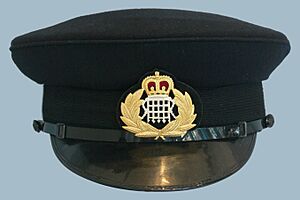Waterguard facts for kids
The Waterguard was a special group of officers in the United Kingdom. They were part of a bigger department called HM Customs and Excise. Their main job was to check ships, planes, vehicles, and people entering or leaving the UK. This included passengers, crew members, and even people walking across borders.
Waterguard officers made sure that people followed the rules about what they could bring into the country. They also collected taxes on goods, which is called "customs and excise revenue." They were also responsible for stopping illegal items from entering or leaving the country. In 1972, the Waterguard changed its name to the 'Preventive Service'. This group continued its work as part of HM Customs and Excise until 2008. After that, a new agency called the UK Border Agency took over some of their duties.
Contents
The Waterguard's Story
Fighting Smuggling: The Early Days
The Waterguard started in 1809. It was first called the "Preventive Waterguard" or the "Preventive Boat Service." Their main goal was to stop smuggling. Smuggling is when people secretly bring goods into or out of a country without paying taxes or following the rules.
At that time, there were other groups fighting smuggling too. "Riding officers" rode horses along the coast. "Cutters" were special boats that patrolled the sea. The Waterguard worked alongside these groups.
The Waterguard officers first worked from small buildings called watch houses along the coast. Their boat crews would patrol the waters near the shore every night in small boats.
Changes and New Names
For a few years, from 1816 to 1822, the British Admiralty (which manages the navy) was in charge of the Waterguard. Then, the Waterguard, riding officers, and cutters all joined together under HM Customs. This new combined group was renamed the HM Coast Guard. The Coast Guard itself later came under the Admiralty's control in 1856.
Over time, the Coast Guard focused less on stopping smuggling. So, in 1891, the Waterguard was re-formed as part of HM Customs. In 1909, it became a full part of the Customs and Excise department.
Expanding Their Work
After 1923, the name "Waterguard" became a bit confusing. This was because their work expanded beyond just water borders. They started working at the border between Northern Ireland and the Irish Free State (which is now the Republic of Ireland). They also began checking people and goods at airports and other entry points into the United Kingdom.
Waterguard officers were often simply called "customs officers." However, until 1972, there was a difference. Regular Customs and Excise officers did not wear uniforms. They focused on checking cargo (goods being shipped) and collecting a tax called Purchase Tax. When Purchase Tax was replaced by another tax called VAT, HM Customs and Excise became responsible for that too.
See also
- HM Coastguard
- HM Customs and Excise


